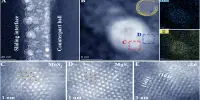Eight of the universe’s hottest stars have been found by an international team of astronomers; all of them have surfaces that are hotter than 100,000 degrees Celsius. Monthly Notices of the Royal Astronomical Society published the research.
The Southern African Large Telescope (SALT), which has a 10m × 11m mirror and is the largest optical telescope in the southern hemisphere, was used to collect the data used in this research. The paper describes the discovery of many extremely hot white dwarf and pre-white dwarf stars, the hottest of which has a surface temperature of 180,000 degrees Celsius, through a survey of helium-rich subdwarf stars. The surface of the sun is just 5,800 degrees, for instance.
One of the identified stars is the one light year diameter center star of a recently discovered planetary nebula. The other two stars are “variable” or pulsing stars. These stars are all in an advanced stage of their evolution and are on the verge of becoming white dwarfs. Each of these new findings is more than 100 times brighter than the sun, which is rare for white dwarf stars due to their extraordinarily high temperatures.
White dwarfs are similar in size to Earth but a million times more massive, having masses that are more similar to that of the sun. They are the universe’s densest stars made of ordinary materials. Pre-white dwarfs are a few times larger than white dwarfs, which they will eventually become in a few thousand years.
The study’s principal investigator, Armagh Observatory and Planetarium astronomer Simon Jeffery, states, “Extremely uncommon stars have effective temperatures of 100,000 degrees Celsius or higher. Finding so many of these stars in our survey came as a complete surprise. These discoveries show how well-suited SALT is to our study and will contribute to our understanding of the final phases of star evolution.” He continues, “Working with an experienced team has been exhilarating; together, we were able to detect the stars, analyze their atmospheres, find pulsations, and find a nebula in a very short period of time.”
Professor Klaus Werner, a co-author of the study from the University of Tuebingen, said, “I am happy to have contributed to the development of this groundbreaking research. We expect that the discovery of a new planetary nebula, eight very hot white dwarf and pre-white dwarf stars, and many other discoveries will serve us shed new light on the birth of our galaxy.
It is an honor to have contributed to this amazing finding, says Dr. Itumeleng Monageng of the Department of Astronomy, University of Cape Town, and South African Astronomical Observatory. The goal of the SALT survey of hot, helium-rich subdwarf stars was to investigate the evolution of groups of highly developed stars.
The discovery of eight brand-new, incredibly hot stars, one of which is encircled by a planetary nebula, is exciting.
















